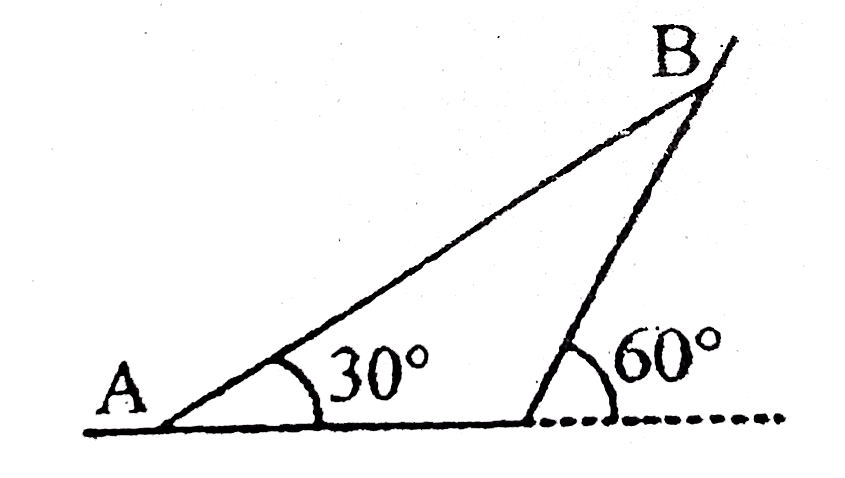One end of a cylindrical glass rod shown in figure, is ground to a hemispherical surface of radius R=20mm.

a. Find the image distance of a point object on the axis of the rod, 80mm to the left of the vertex. The rod is in air.
b. Let the same rod be immersed in water of refractive index 4/3 , the other quantities having the same values as before. Find the image distance.
a. μ1=1,μ2=1.5,R=+2mm,u=+80mm
1.5v−18=1.5−1−20
v′=+120mm
The image is therefore formed at the right of the vertex.
( v is positive and at a distance of 120 mm from it.)
b. 1.5v+−1.33−80=1.5−1.33+20,v=−180mm
The fact theat v is negatvie means that the rays after refraction by the surface are not converging but appear to diverge from a pint 180mm to the left of the vertex. In the illustration, then, the surface forms a virtual image 180mm to the left of the vertex.
Topper's Solved these Questions
- GEOMETRICAL OPTICSBOOK - CENGAGE PHYSICSCHAPTER - GEOMETRICAL OPTICSEXERCISE - Exercise1.6
15 Videos
- GEOMETRICAL OPTICSBOOK - CENGAGE PHYSICSCHAPTER - GEOMETRICAL OPTICSEXERCISE - Exercise1.7
21 Videos
- GEOMETRICAL OPTICSBOOK - CENGAGE PHYSICSCHAPTER - GEOMETRICAL OPTICSEXERCISE - Exercise1.4
12 Videos
- FRICTIONBOOK - CENGAGE PHYSICSCHAPTER - FRICTIONEXERCISE - QUESTION BANK
1 Video
- GRAVITATIONBOOK - CENGAGE PHYSICSCHAPTER - GRAVITATIONEXERCISE - Question Bank
39 Videos
Similar Questions
One end of a cylindrical rod is grounded to a hemispherical surface of radius R = 30 mm. The refractive index of rod is 1.5. Find the position of the image placed on the axis of the rod at 10 cm from the pole.
View SolutionThe left end of a long glass rod of index 1.6350 is grounded and polished to a convex spherical surface of radius 2.50 cm. A small object is located in the air and on the axis 9.0 cm from the vertex. Find the lateral magnification.
View Solution
Knowledge Check
In the figure shown the instantaneous speed of end A of the rod is v to the left the angular velocity of the rod of lengthL must be
 Av/2LBv/LCv√3/2LDnone
Av/2LBv/LCv√3/2LDnoneIn the figure shown, the instantaneous speed of end A of the rod is v to the left. The angular velocity of the rod of length L must be
 Av2LBvLCv√32LDnone of these
Av2LBvLCv√32LDnone of these
One end of a cylindrical rod is grounded to a hemispherical surface of radiusR=20mm.It is immersed in water(μ=4/3).If the refractive index of the rod is1.5and an object is placed in water on the axis at a distance of10cmform the pole ,then the position of the image is ................(determine)
View SolutionOne end of a cylindrical glass rod (mu = 1.5) of radius 1.0 cm is rounded in the shape of a hemisphere. The rod is immersed in water (mu= 4/3) and an object is placed in the water along the axis of the rod at a distance of 8.0 cm from the rounded edge. Locate the image of the object.
View SolutionOne end of a glass rod 8cm in diameter has a hemishperical surface of 4cm radius. Determine the position of the image of an object placed on the axis at following distance from the hemishperical end (a) at infinity, (b) 16cm, (c ) 4cm, refractive index of the glass is 1.5.
View SolutionOne end of a horizontal cylindrical glass rod (μ=1.5) of radius 0.5cm is rounded in the shape of a hemisphere. An object 0.5mm high is placed perpendicular to the axis of the rod at a distance of 20.0cm from the rounded edge. Locate the image of the object and find its height

View SolutionOne end of a horizontal cylindrical glass rod (μ=1.5) of radius 5.0 cm is rounded in the shape of a hemisphere. Asnobject 0.5 mm high is placed perpendicular to the axis of the rod at a difference of 20.0 cm from the rounded edge. Locate the image of the object and find its height.
View SolutionOne end of a long glass rod (μ=1.5) is formed into a convex surface of radius 6.0cm. An object is positioned in air along the axis of the rod. Find the image positions corresponding to object distances of (a) 20.0cm, (b) 10.0cm, (c) 3.0cm from the end of the rod.
View Solution